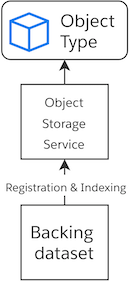18 - What happens when you save?
This content is also available at learn.palantir.com ↗ and is presented here for accessibility purposes.
When you save your object type and the associated dataset-to-object-type mapping, you trigger two actions in the background. A good understanding of this process will help you troubleshoot any errors that may occur when editing your object type, its properties, or its links to other object types.
Objects in Palantir are stored in a designated storage service. When you interact with the object layer, you do not directly touch the backing dataset; instead, you query the storage service via the user interface to obtain details about your object. Clicking Save:
-
Registers your table in the storage service, which locks your backing dataset to this object type.
- If you make schema changes to your backing dataset, you will need to re-register your object type using the Update button in OMA's Datasources tab.
- If you want to delete your object type and re-use your backing dataset for another object type, you will need to first click the red Unregister button in the Datasources tab.
-
Indexes your table. When you define a dataset-object type mapping, the storage service will index the mapped properties so they can be searched from object interfaces (e.g., Workshop Modules, Object Views). The dataset-object type mapping activities in the previous task determine which properties are indexed and how.
From this point forward, your object type is backed by the table in the object storage service, which remains responsive to backing dataset updates. So when new rows are added to the dataset, new objects will be added to your object type. You will deepen your understanding of this storage service in a future tutorial.

📚 Recommended Reading (~4 min read)
Take a moment to read about saving your Ontology changes and troubleshooting steps.